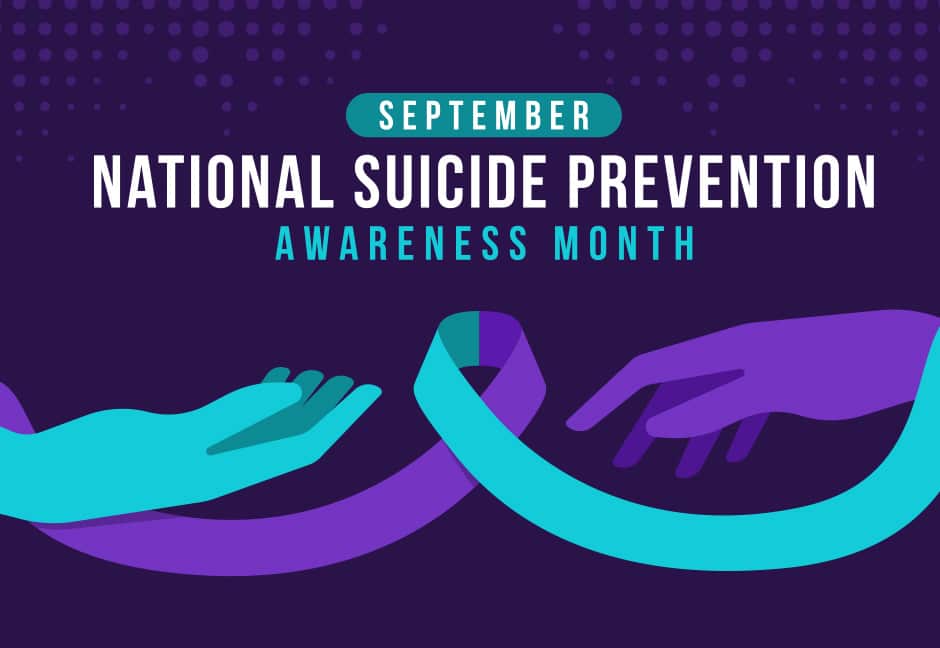5 Actionable Steps to Take For Suicide Prevention
The MIND 24-7 Team | September 23, 2023
Suicide prevention awareness month happens every September to remember those who died by suicide, acknowledge the people impacted by suicide, educate people on the warning signs and risks, share resources for help, and encourage hope. It is a dedicated time to focus on mental health and shine a light on a topic that is often hidden. It is important to recognize that it is okay to talk about suicide and that suicide can be prevented. In this blog, we highlight key actions people can take to prevent suicide.
FOR HELP RIGHT NOW:
- The National Suicide Prevention Lifeline: call 988.
- Crisis Text Line: text TALK to 741741.
- The Trevor Project: text START to 678-678 or call 1-866-488-7386 or chat online. (Note: the Trevor Project serves LGBTQIA+ youth.)
Know the risks
According to the CDC, suicide is rarely caused by a single event or circumstance. A range of situations and problems can increase the risk that a person will attempt suicide. These may include personal challenges such as a history of depression, relationship difficulties like bullying, community challenges like violence, and societal issues such as stigma with seeking help.
Another way to think about the risk factors of suicide is based on the Interpersonal Theory of Suicide, which says that the risk of suicide is high when the following three factors exist:
- A person feels that they are a burden to others.
- A person believes that they do not belong.
- A person has the capability to kill themselves.
Keep up with the social media trends
People are talking about suicide on social media without using the word suicide. Staying up to date with social media code words and trends is crucial to recognizing the warning signs, having productive conversations, and preventing suicide. Whenever someone searches for #suicide on TikTok, the app shows the number for a local crisis helpline. No content can be linked to that hashtag or any others that use the word “suicide.” So, TikTokers use the hashtags #unalivemeplease and #unaliving to talk about suicide.
TikTokers also use other creative ways to talk about mental health and suicide. Phrases and concepts from a poem by Hannah Dains titled Don’t Kill Yourself Today are popular in posts about suicide. The poem lists reasons to keep on living for one more morning, “even if it takes 10,000 of those “one more mornings” before you get to “I can’t wait for tomorrow.” The poem includes lines such as “Don’t kill yourself until you tell someone your best pasta recipe” and “Don’t kill yourself until you finish your shampoo and conditioner at the same time.” TikTokers will reference the poem to talk about hope and courage to overcome mental health challenges and they will also reference the poem in times of crisis. If someone says, “My Netflix subscription ran out” or “I finished my shampoo and conditioner at the same time,” it is likely a sign they are struggling and need help.
Recognize the warning signs
In addition to looking out for warning signs on social media, it is also important to understand the warning signs in real life. From the National Institute of Mental Health, here are a few behaviors that may be a sign someone is thinking about suicide:
- Talking about wanting to die.
- Talking about feeling guilty or shameful.
- Talking about being a burden to others.
- Feeling hopeless or extremely sad.
- Having big mood swings.
- Taking dangerous risks.
- Withdrawing from friends and saying goodbye.
Make a safety plan
A safety plan is a type of mental health crisis plan people can make on their own or with a provider if they think about harming themselves or struggle with suicidal thoughts. Safety plans come in many shapes and sizes, ranging from informal notes to legal documents. People can create a safety plan on their own or with help from a therapist, friend, or family member.
A safety plan commonly includes:
- Wellness tools
- Coping skills
- Descriptions of stressors and triggers
- Steps to remove dangerous objects from a person’s environment
- Early crisis warning signs
- A list of steps to follow in a crisis
- Resources to access during a crisis
- A post-crisis plan
Know who to call and where to go for help
When a person is having suicidal thoughts, it is important to get help right away. Here are some resources:
- The National Suicide Prevention Lifeline: call 988.
- Crisis Text Line: text TALK to 741741.
- The Trevor Project: text START to 678-678 or call 1-866-488-7386 or chat online. (Note: the Trevor Project serves LGBTQIA+ youth.)
- MIND 24-7: MIND 24-7 offers walk-in treatment for mental and behavioral health concerns, including depression and suicidal thoughts. We are open 24 hours a day, every day of the year, including holidays, and we can help anyone who walks in needing mental health care. All adults and youth are welcome—regardless of their ability to pay. We accept private insurance, Medicare, and AHCCCS, and will never turn someone away. Through Crisis Care, a child or adult experiencing a crisis can get help, stabilize, and go home or move to inpatient care. If you or a loved one needs mental health care in minutes—not days or weeks—visit one of our convenient locations in the Phoenix area or text/call 1-844-MIND247.

